You're using an outdated browser. Please upgrade to a modern browser for the best experience.

Submitted Successfully!
Thank you for your contribution! You can also upload a video entry or images related to this topic.
For video creation, please contact our Academic Video Service.
| Version | Summary | Created by | Modification | Content Size | Created at | Operation |
|---|---|---|---|---|---|---|
| 1 | Fernando Lessa Tofoli | + 2333 word(s) | 2333 | 2021-04-22 03:41:38 | | | |
| 2 | Lily Guo | Meta information modification | 2333 | 2021-05-06 05:49:25 | | | | |
| 3 | Lily Guo | Meta information modification | 2333 | 2021-05-06 06:15:55 | | |
Video Upload Options
We provide professional Academic Video Service to translate complex research into visually appealing presentations. Would you like to try it?
Cite
If you have any further questions, please contact Encyclopedia Editorial Office.
Tofoli, F.L. Switched-Capacitor-Based Converters. Encyclopedia. Available online: https://encyclopedia.pub/entry/9241 (accessed on 14 December 2025).
Tofoli FL. Switched-Capacitor-Based Converters. Encyclopedia. Available at: https://encyclopedia.pub/entry/9241. Accessed December 14, 2025.
Tofoli, Fernando Lessa. "Switched-Capacitor-Based Converters" Encyclopedia, https://encyclopedia.pub/entry/9241 (accessed December 14, 2025).
Tofoli, F.L. (2021, April 30). Switched-Capacitor-Based Converters. In Encyclopedia. https://encyclopedia.pub/entry/9241
Tofoli, Fernando Lessa. "Switched-Capacitor-Based Converters." Encyclopedia. Web. 30 April, 2021.
Copy Citation
An extensive entry of basic concepts and switched capacitor structures employed in the conception of DC-DC converters is presented.
Switched capacitors
DC-DC converters
1. Introduction
DC-DC converters are widely used in residential, commercial, and industrial applications, such as renewable energy conversion systems, electric traction devices, and, mainly, power supplies. Currently, it is estimated that more than 70% of electricity is processed by electronic devices [1]. In this context, increasing the power processing capacity and power density of converters associated with reduced manufacturing costs is of major concern.
The evolution of low-power electronics is mainly related to the increase in the purity of materials and advanced techniques used in the manufacture of integrated circuits (ICs) [2]. This also has a direct impact on power electronics, which seeks to increase the power levels and maximum operating frequency associated with reduced dimensions of power converters [3]. Recently, new semiconductors have become commercially available, which are based on silicon carbide (SiC) and gallium nitride (GaN). These elements have promising characteristics that allow the gradual replacement of silicon-based (Si) devices owing to their higher efficiency and operating frequency. Besides, there is the possibility of combining both manufacturing technologies in a single component [4][5][6].
In turn, energy storage devices such as capacitors and inductors, which are typically used as filters, also contribute directly to the improved performance of power converters. This is owing to the use of dielectric materials with optimized characteristics in capacitors [7][8]. Besides, new ferrosilicon alloys are capable of achieving higher magnetic permeability with reduced hysteresis and eddy current losses in the inductor cores [9][10][11].
In the constant search for higher power density in power converters, topologies using switched capacitors (SCs) have recently aroused the interest of industry and academia. These structures have been adopted in low power electronic applications, especially in systems with limited physical dimensions and involving high energy density. Their characteristics allow monolithic integration [12][13], minimized levels of electromagnetic interference (EMI) [14][15][16], as well as reduced weight and volume.
However, despite the aforementioned advantages, these circuits may present low efficiency [17]. This aspect is particularly influenced by the intrinsic characteristics of the switches and capacitors used in the circuit, and the number of components must also be carefully considered [18]. The regulation of the load voltage is another challenge because, in certain operation conditions, the duty cycle does not have a linear relationship with the output voltage, which implies an increase in the complexity of the control systems [19].
SC circuits can also be combined with traditional structures based on inductors for obtaining families of hybrid converters, resulting in improved load voltage regulation and extended conversion ratio when compared with topologies composed only of capacitors and semiconductors [20][21]. An example of a pseudo SC bandpass filter can also be found in [22]. Another hybrid approach lies in resonant SC converters, which allow increasing the power processing capacity and power density as demonstrated in [23]. Considering that the combination of SCs and inductors leads to a wide variety of topologies, this analysis is beyond the scope of this work.
2. SC Structures
Although voltage multiplier circuits are simple structures widely known and described in analog electronics textbooks, they are still used in applications where high DC voltages must be obtained from an AC voltage source. Voltage multipliers are typically used in X-ray machines, scanning electron microscopes, and particle accelerators, among other devices, because they are simple and low-cost circuits [24][25][26].
In the literature, there are some SC structures dedicated to specific applications, which are often derived from basic converters [27][28][29][30][31][32][33][34]. A description of SC topologies and voltage multipliers used in the conception of non-isolated dc-dc converters for high step-up applications is presented in [35]. However, this study is specifically focused on the thorough analysis of existing techniques for extending the conversion range of non-isolated dc-dc converters. Some relevant issues for the design of SC-based converters are not addressed in [35], e.g., the proper choice of components, the charging mode of capacitors, evaluation of efficiency associated with relevant practical aspects, and control techniques aiming to achieve the output voltage regulation.
It is worth mentioning that there is a wide variety of circuits that employ inductors and SCs in the form of hybrid topologies, especially for wide conversion range applications [36][37][38][39][40][41][42][43][44][45][46][47][48][49][50][51][52][53][54][55][56][57][58][59][60][61][62][63][64][65]. Owing to the existence of a great diversity of combinations with distinct characteristics, this work is dedicated to the analysis of classical topologies based on the use of only semiconductors and capacitors, resulting in the so-called “pure SC” converters.
2.1. Greinacher Voltage Doubler (1914)
The simplest structure of a step-up converter that uses switches and capacitors is the Greinacher voltage doubler, which is shown in Figure 1 [66]. This circuit is powered by an AC source and operates according to two stages. In the first one, the capacitor is charged to the peak value of the source voltage. In the second one, the previously charged capacitor is placed in series with the source and supplies a load. This combination generates a voltage that is ideally equal to twice the input voltage [67].
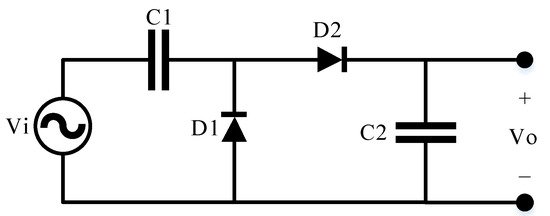
Figure 1. Greinacher voltage doubler.
Being a simple structure, this was one of the first topologies capable of stepping up the voltage across a load powered by an AC source using only passive semiconductors and capacitors. This circuit or cell can be connected in a modular way in series or parallel with phase opposition, thus allowing the achievement of high voltages [68][69].
2.2. SC Voltage Doubler
Although the voltage step-up circuit shown in Figure 1 may be useful in some applications, its use is only feasible when an AC voltage source is available. However, many electronic circuits are powered by DC sources. The SC voltage doubler (SCVD) circuit shown in Figure 2 is a suitable alternative in this case [70][71].
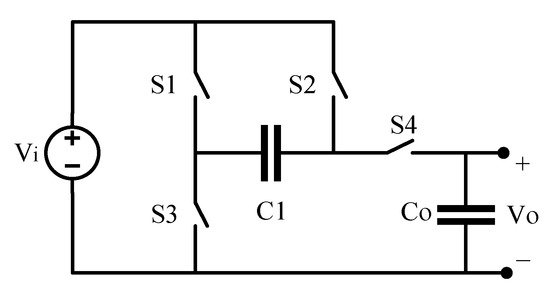
Figure 2. SCVD.
This structure employs active switches to control the charge and discharge of the capacitors. The circuit operates in the same way as the voltage multiplier, i.e., there are two stages. In the first one, the charge of capacitor C1 occurs. In the second one, capacitor C1 is connected in series with the source and the load. It is possible to employ the connection of several cells in series to obtain a given gain 2n
, where n is the number of associated stages. Thus, it is possible to obtain high voltage gains, which allow supplying loads with high output voltages.
2.3. Cockcroft Walton Voltage Multiplier or Ladder Structure (1932)
To supply a particle accelerator with a voltage of 1 MV, Cockcroft and Walton used a circuit powered by an AC source, substantially increasing the output voltage [72]. This circuit became known as Cockcroft and Walton voltage multiplier (CWVM), or simply voltage multiplier, which is exemplified in Figure 3 in terms of several stages. This is one of the best-known structures in electronics to obtain high gains owing to the simplicity of the circuit, low cost, and simple implementation. Considering the components as ideal, the output voltage Vo can be obtained by n⋅Vi, where n is the number of associated cells and Vi is the input voltage.
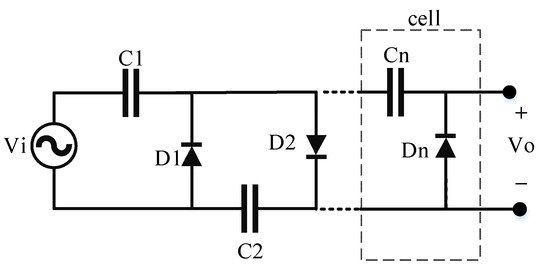
Figure 3. CWVM.
Recent works point to the possibility of using this structure in several modern applications involving high-gain DC-DC converters associated with photovoltaic modules [73][74] and even high power factor rectifiers [75][76][77].
In the CWVM, the source provides some charge Q to capacitor C1 and, in each half cycle of the AC input voltage, the charge Q is transferred from capacitor to capacitor (C2, C3, …), until it reaches the last element Cn. This process involves shifting the charge through each diode similarly to a ladder, which justifies the name given to the circuit.
An inherent problem with this topology is that its output impedance increases by an n3 factor as the number of stages increases. This characteristic limits the output current to low values, as in the case of high currents; the output voltage will decrease rapidly owing to losses [78].
2.4. Series-Parallel Converter (1971)
A proposed alternative to overcome the main limitations of the CWVM in terms of voltage regulation is the series-parallel converter (SPC) shown in Figure 4 [79]. This converter is very versatile since each cell can be associated in series or parallel, and the output voltage can be modified at any time.
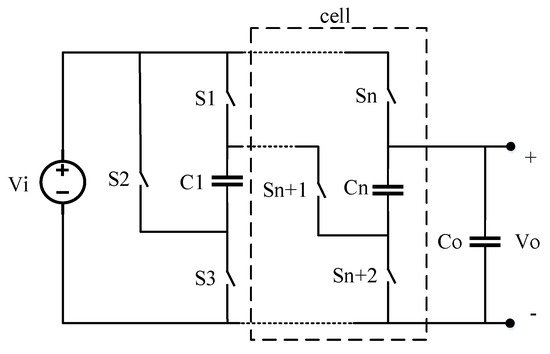
Figure 4. SPC.
As the name suggests, the energy transfer from the input to the output occurs when connecting some of the capacitors in parallel with the source during the charge stage. In a second moment, the capacitors are associated in series and supply the load. This arrangement has some remarkable advantages because it does not present the same problems as the CWVM, especially concerning the high output impedance. However, there are other drawbacks, such as the simultaneous charging of many capacitors, which can demand a high current from the source in a short time. Also, if many capacitors are in charging process, the voltage ripple at the output may be high, directly impacting the converter efficiency. Depending on the length of the connection tracks on the printed circuit boards (PCBs), the arrangement of the elements, and the number of capacitors, there may still be problems due to parasitic capacitances, drastically reducing the efficiency of the circuit in the event of high voltage gains [80].
2.5. Series-Parallel Multiphase Converter (1973)
Another alternative to overcome the problems presented by the CWVM and the SPC is the series-parallel multiphase converter (SPMC) [81], which is shown in Figure 5. In this way, it is possible to mitigate the transients of the input current and the effect of parasitic capacitances. While part of the capacitors is connected to the source during the charge cycle, the other components that are fully charged are connected to the load. Meanwhile, part of the other series-connected capacitors remains in an intermediate charge state. Therefore, there are at least two or three phase-shifted signals controlling the connection of the capacitors with the source and the load.
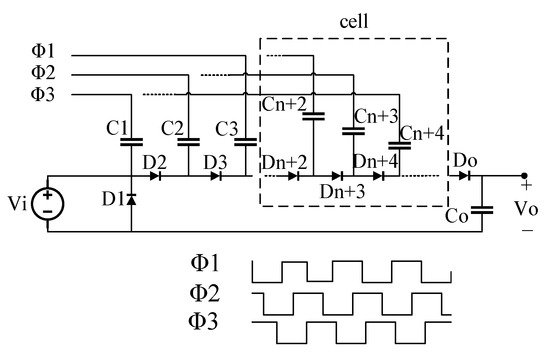
Figure 5. SPMC.
2.6. Dickson Converter (1976)
Dickson implemented the first integrated multiphase voltage multiplier in which the circuit reached an output voltage of 40 V from a 15 V source [82]. Besides the innovation inherent in the introduction of the topology itself, it should be noted that this was the first structure built experimentally in a totally encapsulated form. Figure 6 shows the Dickson converter.
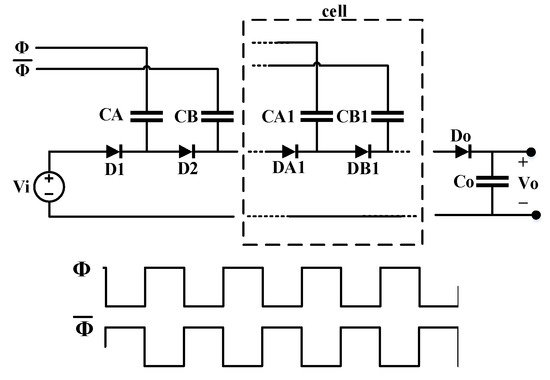
Figure 6. Dickson converter.
In the literature, there are several publications dedicated to the study of this topology aiming at improving aspects such as efficiency, dynamic response, and regulation [83][84][85]. A limitation of this structure lies in the fact that it does not present good performance in high-power applications owing to the difficulty of obtaining adequate regulation and the low efficiency when it is desired to obtain high voltage gains.
2.7. Fibonacci Converter (1991)
When the first SC converters were designed, the power levels were initially limited to milliwatts or a few units of watts. A natural next step would be to reduce the number of components of these structures, aiming at increasing the gain, power levels, and efficiency. In this sense, the Fibonacci converter (FC) was proposed as a multiphase topology in which the capacitors are associated in series and parallel. In this case, the cells are combined with the source and with each other to achieve the desirable voltage gain [86]. The FC is presented in Figure 7 and receives this name because of its gain characteristic, since each cell/stage coupled to the converter leads to an increase in the output voltage following a proportion defined by the Fibonacci sequence (2, 3, 5, 8, 13, …).

Figure 7. FC.
The FC is very similar to the SPC, differing mainly in the way the capacitors are connected. At this point, it should be noted that among the topologies presented so far that use the combination of capacitors in series and parallel, the highest gain by the association of stages is obtained with the FC [15][87].
2.8. Ladder Converter (1992)
The CWVM can produce high voltages from a low-voltage source, but there are limitations to this structure, such as the high output impedance that prevents high gains from being achieved. In general, it can be stated that as the gain increases, the output impedance also does by a cubic factor [79], which can compromise the output voltage regulation for loads requiring high currents.
The basic ladder cells are shown in Figure 8, which are derived from a study regarding the proposal of a three-level neutral point clamped (NPC) inverter topology [88][89]. The inverter described in [88][89] works with three voltage levels: Vi, Vi/2, and 0 V, and it is called capacitor-clamped multilevel inverter or flying capacitor multilevel inverter (FCMLI). This is a circuit similar to the NPC inverter, but the diodes are replaced by capacitors.
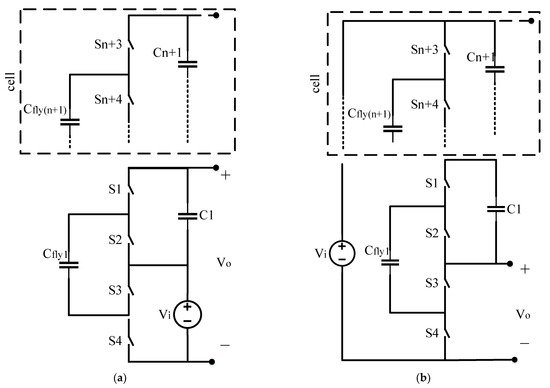
Figure 8. (a) Boost and (b) buck ladder cells.
These cells can be arranged in the form of boost and buck configurations as shown in Figure 8a,b, respectively. A converter based on this topology can consist of one or more cells according to the desired conversion ratio. When the converter works in voltage step-up mode, the source is associated in series with n capacitors charged with a voltage Vi. The flying capacitor at a given moment is connected in parallel with the source to be charged. Still, later it is connected in parallel with the other capacitor to charge it with Vi. In this way, the voltage source in series with n charged capacitors can produce an output voltage Vo according to Equation (1).

when used as a step-down topology, the converter operates similarly to a capacitive voltage divider formed by n capacitors in series, in which the load is connected in parallel with one of the capacitors. In this circuit, there are also one or more flying capacitors Cfly, which at a given moment are connected in parallel with the source and later on associated in parallel with the elements that form the capacitive divider. This arrangement produces an output voltage that varies according to the number of capacitors used in the converter as defined by Equation (2):

where ncap is the number of series capacitors in the circuit. Figure 9a shows a boost-type ladder converter with a gain equal to two and Figure 9b presents a buck converter with a gain equal to 0.5. This topology is also efficient in AC-AC conversion, with good regulation and high power factor, and it is a feasible option to replace ferromagnetic core transformers [90].
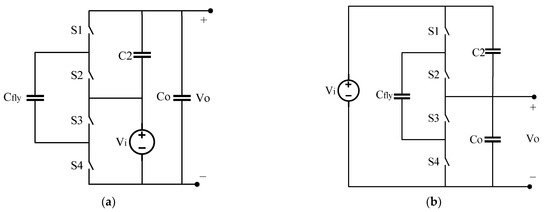
Figure 9. (a) Boost and (b) buck ladder converters.
References
- Bose, B.K. Global energy scenario and impact of power electronics in 21st century. IEEE Trans. Ind. Electron. 2013, 60, 2638–2651.
- Baliga, B.J. Trends in power semiconductor devices. IEEE Trans. Electron. Devices 1996, 43, 1717–1731.
- Bose, B.K. Evaluation of modern power semiconductor devices and future trends of converters. IEEE Trans. Ind. Appl. 1992, 28, 403–413.
- Biela, J.; Schweizer, M.; Waffler, S.; Kolar, J.W. SiC versus Si—evaluation of potentials for performance improvement of inverter and DC–DC converter systems by SiC power semiconductors. IEEE Trans. Ind. Electron. 2011, 58, 2872–2882.
- Zhan, A.; Dang, G.T.; Ren, F.; Cho, H.; Lee, K.-P.; Pearton, S.J.; Chyi, J.-I.; Nee, T.-Y.; Chuo, C.-C. Comparison of GaN pin and Schottky rectifier performance. IEEE Trans. Electron Devices 2001, 48, 407–411.
- Chowdhury, S.; Stum, Z.; Li, Z.D.; Ueno, K.; Chow, T.P. Comparison of 600V Si, SiC and GaN power devices. Mater. Sci. Forum 2014, 778–780, 971–974.
- González, A.; Goikolea, E.; Barrena, J.A.; Mysyk, R. Review on supercapacitors: Technologies and materials. Renew. Sustain. Energy Rev. 2016, 58, 1189–1206.
- Zubieta, L.; Bonert, R. Characterization of double-layer capacitors (DLCs) for power electronics applications. In Proceedings of the Conference Record of 1998 IEEE Industry Applications Conference. Thirty-Third IAS Annual Meeting (Cat. No.98CH36242), Saint Louis, MO, USA, 12–15 October 1998; Volume 2, pp. 1149–1154.
- Shokrollahi, H.; Janghorban, K. Soft magnetic composite materials (SMCs). J. Mater. Process. Technol. 2007, 189, 1–12.
- Kunz, W.; Grätzer, D. Amorphous alloys for switched-mode power supplies. J. Magn. Magn. Mater. 1980, 19, 183–184.
- Li, Z.; Yao, K.; Li, D.; Ni, X.; Lu, Z. Core loss analysis of Finemet type nanocrystalline alloy ribbon with different thickness. Prog. Nat. Sci. Mater. Int. 2017, 27, 588–592.
- Texas Instruments. LM2750 Low-Noise Switched-Capacitor Boost Regulator. Available online: (accessed on 1 March 2021).
- ON Semiconductor. NCP 1719 Switched Capacitor Voltage Inverter. Available online: (accessed on 1 March 2021).
- Tan, S.-C.; Nur, M.; Kiratipongvoot, S.; Bronstein, S.; Lai, Y.-M.; Tse, C.; Ioinovici, A. Switched-capacitor converter configuration with low EMI emission obtained by interleaving and its large-signal modeling. In Proceedings of the 2009 IEEE International Symposium on Circuits and Systems, Taipei, Taiwan, 24–27 May 2009; pp. 1081–1084.
- Ioinovici, A. Switched-capacitor power electronics circuits. IEEE Circ. Syst. Mag. 2001, 1, 37–42.
- Tsai, K.; Qi, F.; Davidson, E.; Xu, L. Common mode EMI noise characterization and improvement for GaN switched-capacitor converter. In Proceedings of the IEEE Energy Conversion Congress and Exposition, Denver, CO, USA, 15–19 September 2013; pp. 4159–4165.
- Zhu, G.; Ioinovici, A. Steady-state characteristics of switched-capacitor electronic converters. J. Circ. Syst. Comput. 1997, 7, 69–91.
- Guangyong, Z.; Ioinovici, A. Switched-capacitor power supplies: DC voltage ratio, efficiency, ripple, regulation. In Proceedings of the IEEE International Symposium on Circuits and Systems (ISCAS), Atlanta, GA, USA, 15 May 1996; pp. 553–556.
- Zhu, G.; Wei, H.; Batarseh, I.; Ioinovici, A. A new switched-capacitor dc-dc converter with improved line and load regulations. In Proceedings of the IEEE International Symposium on Circuits and Systems (ISCAS), Orlando, FL, USA, 30 May–2 June 1999; pp. 234–237.
- Das, R.; Seo, G.; Le, H. Analysis of dual-inductor hybrid converters for extreme conversion ratios. IEEE J. Emerg. Sel. Top. Power Electron. 2020, 1–13.
- Assem, P.; Liu, W.; Lei, Y.; Hanumolu, P.K.; Pilawa-Podgurski, R.C.N. Hybrid Dickson switched-capacitor converter with wide conversion ratio in 65-nm CMOS. IEEE J. Solid State Circ. 2020, 55, 2513–2528.
- Oualkadi, A.E.; Cordeau, D.; Paillot, J. High-Q CMOS LC pseudo switched-capacitor bandpass filter with center frequency tuning. In Proceedings of the IEEE International Symposium on Circuits and Systems, Kos, Greece, 21–24 May 2006; p. 3909.
- Ye, Z.; Lei, Y.; Pilawa-Podgurski, R.C.N. The cascaded resonant converter: A hybrid switched-capacitor topology with high power density and efficiency. IEEE Trans. Power Electron. 2020, 35, 4946–4958.
- Ura, K. Contrast mechanism of negatively charged insulators in scanning electron microscope. Microscopy 1998, 47, 143–147.
- Iqbal, S.; Singh, G.K.; Besar, R. A dual-mode input voltage modulation control scheme for voltage multiplier based X-ray power supply. IEEE Trans. Power Electron. 2008, 23, 1003–1008.
- Sun, J.; Ding, X.; Nakaoka, M.; Takano, H. Series resonant ZCS–PFM DC–DC converter with multistage rectified voltage multiplier and dual-mode PFM control scheme for medical-use high-voltage X-ray power generator. IEE Proc. Electr. Power Appl. 2000, 147, 527–534.
- Ahmed, F.U.; Chowdhury, M.H. An asynchronous reconfigurable switched capacitor voltage regulator. In Proceedings of the IEEE 61st International Midwest Symposium on Circuits and Systems (MWSCAS), Windsor, ON, Canada, 5–8 August 2018; pp. 1110–1113.
- Chen, C.; Liu, X. A high-efficiency switched capacitor converter for always-on block. In Proceedings of the 14th IEEE International Conference on Solid State and Integrated Circuit Technology (ICSICT), Qingdao, China, 31 October–3 November 2018; pp. 1–3.
- Lei, H.; Hao, R.; You, X.; Li, F.; Zhou, M. Nonisolated high step-up soft-switching DC-DC converter integrating Dickson switched-capacitor techniques. In Proceedings of the IEEE Energy Conversion Congress and Exposition (ECCE), Portland, OR, USA, 23–27 September 2018; pp. 1247–1252.
- Jiang, J.; Liu, X.; Ki, W.; Mok, P.K.T.; Lu, Y. A multiphase switched-capacitor converter for fully integrated AMLED microdisplay system. IEEE Trans. Power Electron. 2020, 35, 6001–6011.
- Shah, N.; Lajevardi, P.; Wojciechowski, K.; Lang, C.; Murmann, B. An energy harvester using image sensor pixels with cold start and over 96% MPPT efficiency. IEEE Solid State Circ. Lett. 2019, 2, 207–210.
- Chiou, C.W.; Sun, Y.; Lee, C.; Liou, J. Low-complexity unidirectional systolic Dickson basis multiplier for lightweight cryptosystems. Electron. Lett. 2019, 55, 28–30.
- Gunnam, L.C.; Lai, Y.; Sung, G. Differential Dickson voltage multiplier with matching network for radio frequency harvester. In Proceedings of the IEEE International Conference on Consumer Electronics, Taiwan (ICCE-TW), Taipei, Taiwan, 12–14 June 2017; pp. 417–418.
- Dela Cruz, S.; delos Reyes, M.G.; Alvarez, A.; de Leon, M.T.; Roque, C.R. Design and implementation of passive RF-DC converters for RF power harvesting systems. In Proceedings of the TENCON, 2010 IEEE Region 10 Conference, Fukoka, Japan, 21–24 November 2010; pp. 1503–1508.
- Forouzesh, M.; Siwakoti, Y.P.; Gorji, S.A.; Blaabjerg, F.; Lehman, B. Step-up DC–DC converters: A comprehensive review of voltage-boosting techniques, topologies, and applications. IEEE Trans. Power Electron. 2017, 32, 9143–9178.
- Arfin, S.; Mamun, A.A.; Chowdhury, T.; Sarowar, G. Zeta based hybrid DC-DC converter using switched inductor and switched capacitor combined structure for high gain applications. In Proceedings of the IEEE International Conference on Power, Electrical, and Electronics and Industrial Applications (PEEIACON), Dhaka, Bangladesh, 29 November–1 December 2019; pp. 1–4.
- Axelrod, B.; Berkovich, Y.; Ioinovici, A. Switched-capacitor (SC)/switched inductor (SL) structures for getting hybrid step-down Cuk/Sepic/Zeta converters. In Proceedings of the IEEE International Symposium on Circuits and Systems, Kos, Greece, 21–24 May 2006; p. 4.
- Banaei, M.R.; Kazemi, F.M. A modified selective harmonic elimination switching strategy for Hybrid Flying Capacitor Multicell converter. In Proceedings of the 7th International Conference on Electrical and Electronics Engineering (ELECO), Bursa, Turkey, 1–4 December 2011; pp. I-278–I-282.
- Bhaskar, M.; Ganesan, R.G.; Narayanan, K. Interleaved hybrid boost converter with switched capacitor technique. In Proceedings of the IEEE Innovative Smart Grid Technologies, Asia (ISGT Asia), Chengdu, China, 21–24 May 2019; pp. 3890–3895.
- Chen, M.; Hu, J.; Li, K.; Ioinovici, A. A new switched-capacitor based hybrid converter with large step-up DC gain and low voltage on its semiconductors. In Proceedings of the IEEE International Symposium on Circuits and Systems (ISCAS), Montreal, QC, Canada, 22–25 May 2016; pp. 1190–1193.
- Chen, M.; Li, K.; Hu, J.; Ioinovici, A. Hybrid switched-capacitor quadratic boost converters with very high DC gain and low voltage stress on their semiconductor devices. In Proceedings of the IEEE Energy Conversion Congress and Exposition (ECCE), Milwaukee, WI, USA, 18–22 September 2016; pp. 1–8.
- Dantas, M.; Oliveira, F.; Albuquerque, L.; Freitas, I.; Andersen, R. A hybrid bidirectional push-pull DC-DC converter with a ladder switched-capacitor cell. In Proceedings of the IEEE 15th Brazilian Power Electronics Conference and 5th IEEE Southern Power Electronics Conference (COBEP/SPEC), Santos, Brazil, 1–4 December 2019; pp. 1–6.
- Eate, V.K.; Veerachary, M. Analysis of two-input Switched Inductor-Capacitor Hybrid Buck-SEPIC DC-DC converter. In Proceedings of the IEEE Transportation Electrification Conference (ITEC-India), Pune, India, 13–15 December 2017; pp. 1–6.
- Hulea, D.; Muntean, N.; Gireada, M.; Cornea, O. A bidirectional hybrid switched-capacitor DC-DC converter with a high voltage gain. In Proceedings of the International Aegean Conference on Electrical Machines and Power Electronics (ACEMP) & 2019 International Conference on Optimization of Electrical and Electronic Equipment (OPTIM), Istanbul, Turkey, 27–29 August 2019; pp. 289–296.
- Hulea, D.; Muntean, N.; Gireada, M.; Cornea, O.; Serban, E. Bidirectional hybrid switched-inductor switched-capacitor converter topology with high voltage gain. In Proceedings of the 21st European Conference on Power Electronics and Applications (EPE 2019 ECCE Europe), Genova, Italy, 3–5 September 2019; pp. 1–10.
- Janabi, A.; Wang, B. Switched-capacitor voltage boost converter for electric and hybrid electric vehicle drives. IEEE Transact. Power Electron. 2020, 35, 5615–5624.
- Li, S.; Zheng, Y.; Wu, B.; Smedley, K.M. A family of resonant two-switch boosting switched-capacitor converter with ZVS operation and a wide line regulation range. IEEE Transact. Power Electron. 2018, 33, 448–459.
- Kumar, P.; Veerachary, M. Hybrid switched inductor/switched capacitor based quasi-Z-source DC-DC boost converter. In Proceedings of the 2nd IEEE International Conference on Power Electronics, Intelligent Control and Energy Systems (ICPEICES), Delhi, India, 22–24 October 2018; pp. 617–622.
- Leandro, G.M.; Barbi, I. DC-DC hybrid switched-capacitor LLC resonant converter: All switches with VDS=Vin/2. In Proceedings of the IEEE PES Innovative Smart Grid Technologies Conference–Latin America (ISGT Latin America), Gramado, Brazil, 15–18 September 2019; pp. 1–6.
- Lei, Y.; Liu, W.; Pilawa-Podgurski, R.C.N. An analytical method to evaluate flying capacitor multilevel converters and hybrid switched-capacitor converters for large voltage conversion ratios. In Proceedings of the IEEE 16th Workshop on Control and Modeling for Power Electronics (COMPEL), Vancouver, BC, Canada, 12–15 July 2015; pp. 1–7.
- Lei, Y.; Liu, W.; Pilawa-Podgurski, R.C.N. An analytical method to evaluate and design hybrid switched-capacitor and multilevel converters. IEEE Trans. Power Electron. 2018, 33, 2227–2240.
- Lei, Y.; Ye, Z.; Pilawa-Podgurski, R.C.N. A GaN-based 97% efficient hybrid switched-capacitor converter with lossless regulation capability. In Proceedings of the IEEE Energy Conversion Congress and Exposition (ECCE), Montreal, QC, Canada, 20–24 September 2015; pp. 4264–4270.
- Li, G.; Zhiming, C.; Jian, L. Design of a hybrid monolithic integrated switched capacitor DC-DC step-up converter. In Proceedings of the IPEMC 2000. Third International Power Electronics and Motion Control Conference (IEEE Cat. No.00EX435), Beijing, China, 15–18 August 2000; pp. 263–266.
- Pelan, O.; Muntean, N.; Cornea, O. Comparative evaluation of buck and switched-capacitor hybrid buck DC-DC converters. In Proceedings of the International Symposium on Power Electronics Power Electronics, Electrical Drives, Automation and Motion, Sorrento, Italy, 20–22 June 2012; pp. 1330–1335.
- Sadigh, A.K.; Dargahi, V.; Corzine, K.A. Reduction of switches and flying capacitors in a hybrid topology of the stacked multicell converters. In Proceedings of the IECON 2019, 45th Annual Conference of the IEEE Industrial Electronics Society, Lisbon, Portugal, 14–17 October 2019; pp. 4977–4982.
- Sarath, R.; Kanakasabapathy, P. Switched-capacitor/switched-inductor Ćuk-derived hybrid converter for nanogrid applications. In Proceedings of the International Conference on Computation of Power, Energy, Information and Communication (ICCPEIC), Melmaruvathur, India, 22–23 April 2015; pp. 430–435.
- Soares, M.V.; Lambert, G.; Novaes, Y.R. Hybrid switched capacitor DC-DC converter based on MMC. In Proceedings of the IEEE 15th Brazilian Power Electronics Conference and 5th IEEE Southern Power Electronics Conference (COBEP/SPEC), Santos, Brazil, 1–4 December 2019; pp. 1–6.
- Stewart, J.; Richards, J.; Delhotal, J.; Neely, J.; Flicker, J.; Brocato, R.; Rashkin, L. Design and evaluation of hybrid switched capacitor converters for high voltage, high power density applications. In Proceedings of the IEEE Applied Power Electronics Conference and Exposition (APEC), San Antonio, TX, USA, 4–8 March 2018; pp. 105–112.
- Tewari, N.; Sreedevi, V.T. Switched inductor-switched capacitor based high gain hybrid dc-dc converter. In Proceedings of the 8th IEEE India International Conference on Power Electronics (IICPE), Jaipur, India, 13–15 December 2018; pp. 1–6.
- Vecchia, M.D.; Lazzarin, T.B. A hybrid switched capacitor DC-DC buck converter. In Proceedings of the IEEE 13th Brazilian Power Electronics Conference and 1st Southern Power Electronics Conference (COBEP/SPEC), Fortaleza, Brazil, 29 November–2 December 2015; pp. 1–6.
- Vecchia, M.D.; Lazzarin, T.B. Hybrid DC-DC buck converter with active switched capacitor cell and low voltage gain. In Proceedings of the IEEE Energy Conversion Congress and Exposition (ECCE), Milwaukee, WI, USA, 18–22 September 2016; pp. 1–6.
- Veerachary, M.; Reddy, T.N. Voltage-mode control of hybrid switched capacitor converters. In Proceedings of the IECON 2006, 32nd Annual Conference on IEEE Industrial Electronics, Paris, France, 6–10 November 2006; pp. 2450–2453.
- Veerachary, M.; Reddy, T.N. Design and control of hybrid switched capacitor DC-DC converter with different operating conditions. In Proceedings of the International Conference on Advances in Computing, Control, and Telecommunication Technologies, Bangalore, India, 28–29 December 2009; pp. 559–563.
- Veerachary, M.; Sudhakar, S.B. Peak-current mode control of hybrid switched capacitor converter. In Proceedings of the International Conference on Power Electronic, Drives and Energy Systems, New Delhi, India, 12–15 December 2006; pp. 1–6.
- Xiong, S.; Tan, S.; Wong, S. Analysis of a high-voltage-gain hybrid switched-capacitor buck converter. In Proceedings of the IEEE International Symposium of Circuits and Systems (ISCAS), Rio de Janeiro, Brazil, 15–18 May 2011; pp. 1616–1619.
- Greinacher, H. The ionometer and its application to the measurement of radium and röntgen rays. Phys. Z. 1914, 15, 410–415.
- Kind, D.; Feser, K. High Voltage Test Techniques; Elsevier: Amsterdam, The Netherlands, 2001.
- Hwang, F.; Shen, Y.; Jayaram, S.H. Low-ripple compact high-voltage DC power supply. IEEE Trans. Ind. Appl. 2006, 42, 1139–1145.
- Fukuyama, T.; Sugihara, K. Study on operating principle of Cockcroft-Walton circuit to produce plasmas using high-voltage discharge. Plasma Fusion Res. 2016, 11, 2401008.
- Midya, P. Efficiency analysis of switched capacitor doubler. In Proceedings of the 39th Midwest Symposium on Circuits and Systems, Ames, IA, USA, 21–21 August 1996; pp. 1019–1022.
- Cataldo, G.D.; Palumbo, G. Double and triple charge pump for power IC: Dynamic models which take parasitic effects into account. In IEEE Transactions on Circuits and Systems I: Fundamental Theory and Applications; IEEE: Piscataway, NJ, USA, 1993; Volume 40, pp. 92–101.
- Cockcroft, J.D.; Walton, E.T. Experiments with high velocity positive ions. (I) Further developments in the method of obtaining high velocity positive ions. Proc. Math. Phys. Eng. Sci. 1932, 136, 619–630.
- Müller, L.; Kimball, J.W. Dual-input high gain DC-DC converter based on the Cockcroft-Walton multiplier. In Proceedings of the IEEE Energy Conversion Congress and Exposition (ECCE), Pittsburgh, PA, USA, 14–18 September 2014; pp. 5360–5367.
- Müller, L.; Kimball, J.W. High gain DC–DC converter based on the Cockcroft–Walton multiplier. IEEE Trans. Power Electron. 2016, 31, 6405–6415.
- Young, C.; Chen, M. A novel single-phase ac to high voltage dc converter based on Cockcroft-Walton cascade rectifier. In Proceedings of the International Conference on Power Electronics and Drive Systems (PEDS), Taipei, Taiwan, 2–5 November 2009; pp. 822–826.
- Young, C.; Chun-Cho, K.; Chen, M.; Chao-Cheng, W. A Cockcroft-Walton voltage multiplier with PFC using ZC-ZVT auxiliary circuit. In Proceedings of the IECON 2011, 37th Annual Conference of the IEEE Industrial Electronics Society, Melbourne, VIC, Australia, 7–10 November 2011; pp. 1000–1005.
- Young, C.; Chen, M.; Hong-Lin, C.; Jen-Yi, C.; Chun-Cho, K. Transformerless single-stage high step-up AC-DC converter based on symmetrical Cockcroft-Walton voltage multiplier with PFC. In Proceedings of the IEEE Ninth International Conference on Power Electronics and Drive Systems, Singapore, 5–8 December 2011; pp. 191–196.
- Kobougias, I.C.; Tatakis, E.C. Optimal design of a half-wave Cockroft-Walton voltage multiplier with different capacitances per stage. IEEE Transact. Power Electron. 2010, 25, 2460–2468.
- Brugler, J.S. Theoretical performance of voltage multiplier circuits. IEEE J. Solid State Circ. 1971, 6, 132–135.
- Tanzawa, T. On-Chip High-Coltage Generator Design; Springer: Berlin/Heidelberg, Germany, 2013.
- Falkner, A. Generalised cockcroft-walton voltage multipliers. Electron. Lett. 1973, 9, 585–586.
- Dickson, J.F. On-chip high-voltage generation in MNOS integrated circuits using an improved voltage multiplier technique. IEEE J. Solid State Circ. 1976, 11, 374–378.
- Alzahrani, A.; Shamsi, P.; Ferdowsi, M. Analysis and design of bipolar Dickson DC-DC converter. In Proceedings of the IEEE Power and Energy Conference at Illinois (PECI), Champaign, IL, USA, 23–24 February 2017; pp. 1–6.
- Tanzawa, T.; Tanaka, T. A dynamic analysis of the Dickson charge pump circuit. IEEE J. Solid State Circ. 1997, 32, 1231–1240.
- Tanzawa, T. A switch-resistance-aware Dickson charge pump model for optimizing clock frequency. IEEE Trans. Circ. Syst. II Express Briefs 2011, 58, 336–340.
- Makowski, M.S.; Maksimovic, D. Performance limits of switched-capacitor DC-DC converters. In Proceedings of the PESC 1995, Power Electronics Specialist Conference, Atlanta, GA, USA, 18–22 June 1995; pp. 1215–1221.
- Makowski, M.S. Realizability conditions and bounds on synthesis of switched-capacitor DC-DC voltage multiplier circuits. IEEE Trans. Circ. Syst. I Regul. Pap. 1997, 44, 684–691.
- Meynard, T.A.; Foch, H. Multi-level conversion: High voltage choppers and voltage-source inverters. In Proceedings of the PESC 19992 Record, 23rd Annual IEEE Power Electronics Specialists Conference, Toledo, Spain, 29 June–3 July 1992; pp. 397–403.
- Meynard, T.A.; Foch, H.; Thomas, P.; Courault, J.; Jakob, R.; Nahrstaedt, M. Multicell converters: Basic concepts and industry applications. IEEE Trans. Ind. Electron. 2002, 49, 955–964.
- Lazzarin, T.B.; Andersen, R.L.; Martins, G.B.; Barbi, I. A 600-W switched-capacitor AC–AC converter for 220 V/110 V and 110 V/220 V applications. IEEE Trans. Power Electron. 2012, 27, 4821–4826.
More
Information
Subjects:
Others
Contributor
MDPI registered users' name will be linked to their SciProfiles pages. To register with us, please refer to https://encyclopedia.pub/register
:
View Times:
3.6K
Revisions:
3 times
(View History)
Update Date:
06 May 2021
Notice
You are not a member of the advisory board for this topic. If you want to update advisory board member profile, please contact office@encyclopedia.pub.
OK
Confirm
Only members of the Encyclopedia advisory board for this topic are allowed to note entries. Would you like to become an advisory board member of the Encyclopedia?
Yes
No
${ textCharacter }/${ maxCharacter }
Submit
Cancel
Back
Comments
${ item }
|
More
No more~
There is no comment~
${ textCharacter }/${ maxCharacter }
Submit
Cancel
${ selectedItem.replyTextCharacter }/${ selectedItem.replyMaxCharacter }
Submit
Cancel
Confirm
Are you sure to Delete?
Yes
No




